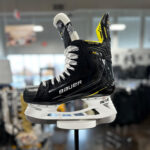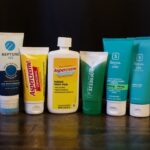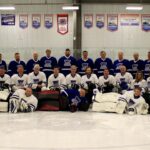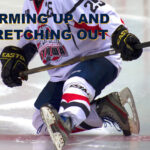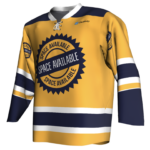Having skated in more than a few hockey development clinics as an adult hockey player, I’ve found there are few that focus not only on skills, but also overall game development. Even fewer are the kinds that offer an intensive experience in a short period of time over the course of a long weekend.
Weekend Warriors Adult Hockey Academy is the ice hockey camp experience that focuses on skill development and game awareness targeting the recreational adult league hockey player. It offers 12 hours of on-ice training over four days in addition to video breakdowns and in-depth analysis to game tactics and strategy.
I have participated in four of these camps in Nashville, Washington, D.C, Lake Tahoe and Atlanta. In this article I would like to take you through my recent experience at the Atlanta camp in April of 2022. This will give you an idea as to the kinds of things you can learn and develop at this intensive hockey camp.
I will state up-front that this is not a sponsored or otherwise promotional piece for Weekend Warriors, but rather my perceptions, review and experience as a recreational hockey player who attended this camp in April of 2022.
What is Weekend Warriors?
Weekend Warriors is an intensive hockey camp designed for adult hockey players of different ages and skill levels with a focus on group and individual coaching. Because the camps are relatively small in size (up to 40 players and six goalies) they offer a good opportunity to have your skills analyzed and coached by one of the six camp coaches.
In addition to the on-ice coaching, the camp includes video review of skating form, scrimmage analysis video, strategy and tactics talks as well as social events with other attendees.
In this article we will break down Weekend Warriors by types of drills as well as day. It is important to note that every camp is unique and tailored to the skill levels of the participants as well as group interests and development ideas. Here are eleven topics covered during the Atlanta camp encompassing on and off ice training:
- Skating development: Edges, strides, starting and stopping. Individual video taken of each skater for analysis of edge work, strides, stopping and starting.
- Puck handling: The four puck positions, skating with the puck while changing positions.
- Passing
- Puck protection: Skating in the different circles keeping possession of your puck while taking possession from others (5 puck). One on one puck protection
- Backward Skating including c-cuts, cross overs and pivoting.
- 5 Individual Minutes with A Coach – For me individually: working on transitioning from offense to defense and vice versa.
- Shooting: Wrist shots and weight transitions. Notably omitted were slap shots.
- Video reviews
- Ice breakers and camp socials.
- Survival tips: Tons of water. Ice packs, heating pads, muscle ointment and laundry detergent. Keep your gear dry the best way you can.
- Goalies: During some drills, goalies are separate from the skaters to work on drills with coaches who are coordinating the drills and taking more consistent and stronger shots on the goalies giving them better training.
Learning the Active Warmup
The first thing to happen at most sessions is an active warmup. This can come as a bit of a culture shock for some players as they’re used to on-ice stretching, stationary stretching utilizing the boards or other forms of muscle warm ups.
The active warmup is designed to cover most of these things while moving as opposed to being stationary. Indeed, it is often better to utilize an active warm up as part of any hockey activity given the time and inclination. More on warmups is covered in our article on warmups which also includes some other thoughts on this topics and ideas for getting in a good warmup prior to your games when time is at a premium.
The active warm up involves skating, neck and shoulder stretching (stick assisted), hip flexors, toe touches, elbow and wrist stick twists and changes in speed/direction to name a few. It is important to note, that there is no stationary stretching done as part of the Weekend Warriors curriculum. They do not advocate for it nor condone it and you will likely be singled out for doing it (in a humorous, way) as a way of discouraging it. I should know, I was “discouraged” from doing this. Shout out to coach Rob on this point..
You Develop Strong Skating Fundamentals
The first session and sometimes even part of the second are spent on some basic skating fundamentals. The time spent on this usually varies based on the skill level of the camp, but being able to get a gauge of skating ability generally helps divide skaters up into the stronger vs weaker groups so you get the most out of camp.
The fundamentals that are worked on during this session include:
- Edge-work
- Inside Edges
- Outside Edges
- Strides
- Right side C-Cuts
- Left side C-cuts
- Alternating C-Cuts
- Side pushes (strides)
- Hockey Stops
I won’t go into this too much in details since these are reasonably self explanatory to folks who have at least laced up the skates for a practice before. Linked are some videos on edge work from folks who have quality videos already on YouTube about this. Note that the videos I have selected are not the prod who make it look super easy, but folks that doing it right, but can also related to the struggle of trying to do inside and outside edge work.
Mastering The Essentials of Stick and Puck Handling
Puck handling drills focused on the four positions of puck control. These are:

Position 1: Forehand side
Position 2: Forehand middle
Position 3: Backhand middle
Position 4: Backhand side
These drills involved both stationary puck control and transitioning from position to position not necessarily in order (going from position 1 to position 4 to position 3 back to position 1, etc). Additional practice is done while moving forward or backward while working with the stick and the puck. (Typically position 4 is the most difficult).
Improving Puck Protection and Slowing Down Your Game
The second and forth days (Friday PM and Sunday AM) were a lot of much protection and learning how to protect the puck so you can slow your game down. This is a great set of skills to work on if, like me, you’re a slower player and want to maintain puck possession to compensate for a lack of speed.
The Five Puck drill is a small group drill of 5 skaters each with a puck and you would try to knock the pucks of other skaters away while maintaining possession of your puck and not having it knocked away. The person who got their puck knocked away, had to skate in a sprint to recover their puck and get back in the drill as quickly as possible.
Another puck protection drill involved pairing up and passing the puck back and forth. On the whistle, the person with the puck tries to maintain possession while the other skater attempts to steal it. When possession changes, the skaters switch roles and keep going until the whistle blows again. On that second whistle, return to passing the puck back and forth
One other drill has two skaters acting as book ends without sticks at first. A third skater skates around them in a figure 8 stance as close to the bookend skaters as possible as they apply pressure, weight, and force to try to disrupt the puck carrier. The goal is not to knock the puck away, but to get the skater used to feeling physical pressure with the puck. Each whistle, the players rotate with one becoming the book end and one of the book ends becoming the skater. A variation of this drill is to use sticks too, but not actively try to knock the puck away. Just apply pressure.
Passing

Passing drills were heavy duty on the third day, particularly in the evening session. While the Saturday morning session was more about backward skating and the scrimmage, the evening drill used the lessons learned during the scrimmage to work on passing drills.
Passing drills such as a the Pass, Curl and Shoot drill as laid out to the right is one such example of the kinds of passing drills.
The skater starts with the puck and passes to the coach at center ice near the center circle. Then they pick up speed and make a tight turn around the far cone and pick up the pass from the coach at game speed and go in for the shot. This drill gives you practice making an accurate, moving pass and receiving a pass after a hard curl and driving the net.
Backward Skating and Pivoting
Standard backward skating was emphasized on multiple of occasions. I am thinking our group was on more of the beginner end of the spectrum because a lot of time was spent on the fundamentals of C-Cuts and Crossovers
Ask skills improved with the drills these were incorporated into drills including pivoting and passing while pivoting. Changing directions and catching passes to then go in for shots on goal. The longes one being the pass, pivot and shoot drill diagramed below.

Two player at position 2 and position 3 act as passing units during this cycle of the drill. The first position is the skater. Skater passes to player two, who passes it back as Player one begins to head toward the circle.
They then pass to the player at position three and transition pivot to go around the circle backward. When they have gone half way, they transition back to going forward and receive a pass from the player at position 3 and go in for the shot on goal.
The overall agenda for backward skating was:
- Backward C-Cuts
- Backward Crossovers
- Backward skating around the outsides of the circles
- Pivoting and changing direction
- Pass, pivot and shooting drills.
Shooting
During this particular camp, there was not a lot of time spent on shooting. The shooting skills revolved around snap shots and wrist shots. It is interesting to note that no slap shot drills were done during skating lessons. I noticed goalies being peppered with slap shots from drill instructors, but not players. I imagine there are reasons of shot quality for this. But still I wish were at least been some instructions on the mechanics of slap shots. Mine is horrendous!
Wrist shots were taken facing the wall and attempting to practice hitting the same place on the wall. Elevating the puck and getting it to the same mark on the boards.
This drill lasted about 15 minutes and you wouldn’t believe how much your back hurts when you do this drill wrong for 10 minutes! It is also very physically exherting. More so than you might expect.
Individual 5 Minutes With A Coach
Each camp gives you the opportunity to spend five uninterrupted minutes with one of the Weekend Warriors coaches in a one on one setting. This can be very helpful provided you have advance knowledge of what you want to discuss with your coach. Going it to it they will not know what you want to work on nor will they really be able to guide you or give you direction on your specific game. It is up to you to know what you want to work on.
If used properly, five minutes is really a good amount of time to spend working on a skill that you can, in turn, take back to your stick time skates and work on during your own practice time.
In my session, I wanted to focus on one of the weaker aspects of my game – the breakout and breakdown transition. I have difficulty transitioning from offense to defense and vice versa on change of possession. In the five minutes I had, I was able to learn how to shift weight to utilize my frame (which as of this writing is sizable) to change direction as well as pivot from one direction to the other. I didn’t become an expert in 5 minutes, but I got an idea of what to do and what I can work on during warmups, open hockey, and stick time skates.
If you are really stumped on ideas, I might suggest a few:
- Backward skating transitions. The keys too pivoting to going backward without stopping.
- If the backward pivot is good, then work on keeping your speed while pivoting forward.
- Stick handling while moving backward.
- Weakside crossovers
- Wrist shot mechanics
- Snap shot mechanics
These are just a few things you can cover in a 5 minute period of time where the key isn’t so much to master the drill, but to learn the tools to help you work on them during other periods of skating – possibly even during warmups between Warrior sessions.
The Scrimmage
Keeping in mind that this is a camp and not a game-strategy scrimmage, the point is to develop individual skills within a team mindset to improve your individual game. As such, there is not much scrimmaging and the one scrimmage that there is is meant to demonstrate the use of skills learned in drills, and strategies learned through chalk talks.
In total, there is one – twenty minute scrimmage during the entire camp – typically on Saturday morning at or near the end of the session.
The scrimmage is video recorded and placed on YouTube for those who wish to view it for their camp, but the overall purposes is for coach review and positioning instruction. Here is the one from the April 2022 camp in Atlanta.
Video Reviews
During the camp, each skater and goalie get a form evaluation. For skaters, they have you do a standard forward skate stopping at each cone, turning and continuing the skate. The goal of this is to evaluate your posture, stride, ability to stop, and your ability to change directions from a stop and carrying your weight through to the next action.
You can see this by looking at my perfect 10 (kidding) skating demonstration to the right. The coaches then would break down each skaters skate during a video review session. Each skater would get at least a good 10 minute critique on posture and all things related to forward skating, stopping and changing directions.
For the scrimmage video review which would happen the next day, they would evaluate plays and decisions made during circumstances of the scrimmage. In all of my camps, they have never fully been able to review the entire scrimmage – but they do break down the fundamental so positioning in all three zones, having good natured fun at the things to be improved on, and use the video to gear the back half of the camp in terms of skills to be worked on.
Chalk Talks: Strategy and Tactics
During the lunch hour and time between sessions, The Warrior coaches will do video presentations, power point instructions and provide valuable information about the mental and strategic aspects of the game. This ranges from the very basics of the rules all the way through complex positioning scenarios indicating ideas of where you should be for your position in anyone situation.
Keep in mind that we’re not NHL players. We’re adult, recreational league hacks. We play the game from a strategy standpoint very differently from the professionals.
Here are a list of topics that were covered during the 2022 camp in Atlanta:
Eyes Of The Puck
Focusing on stick handling and shot selection, it encourages you to see the ice how the puck sees it. Because where your head is and where the puck and your ability to do the physics to determine where you are, where your stick is and, most importantly, where the puck is impacts the shot you can take at any one time.
Defensive Zone Positioning
Going over where the different positions should be inside the defensive zone relative to where the puck and the opposing players are. This one is pretty straight forward.
Breakouts
Different scenarios for how to break the puck out of the zone. This is covered quite a bit on the ice too, so the presentation of this is very relevant to what happens on the ice.
The Neutral Zone
Emphasis on getting through the neutral zone as quickly as possible. One or two passes at the most and get through with as much speed as possible.If pinned down, use a chip off the wall or a dump in to gain the blue like. When breaking out of the zone, use the neutral zone to help support puck possession by being open and available for a pass.
Off-ice exercises for strengthening
This could (and will) be an article unto itself. Discussions about things you can do to work on your game. The Reader’s Digest version is: Squats. Lots of them. You can do them in your house using body weight. I can personally attest to how much squats help with my stride and flexibility in my hips.
Attacking the Zone
Once you have gained the zone, you position yourself based on entry order into the zone.
F1 – The first skater in the zone. Sometimes with the puck, sometimes chasing down a dump. A popular maneuver is for F1 to skate up the boards and curl around and look for the second player F2.
F2 – The second player in the zone. Drives the net. Skates hard to be open for the pass and attack with speed. Can also work to screen goalies or move defenders for F3 to get a shot.
F3 – The third player into the zone. Stays higher such as the high slot to receive a pass or be there for a rebound to keep the puck in the zone or a follow up shot.
Eight Key Factors for Surviving Weekend Warriors
You will burn a lot of calories and sweat more than you might think. As an example, I tracked the calorie burn and several other vital statistic using the Hockey Tracker app for Apple Watch. Below is a breakdown of my heart rate, distance skated speed and calorie burn per skate. You will notice it gradually gets lower, because I get slower!

As you can see, it’s a serious work out. Saturday mornings being the hardest because you are the tightest and it is one the more difficult skates to warm up for – even more than the Sunday morning skate when mentally you can see the physical light at the end of the tunnel.
There are some things you can do to help yourself be prepared for camp so that it is more enjoyable and you get more out of it. First, I should probably put into perspective just how intense the skates are from a workout perspective. Keep in mind that at the time of camp, I was about 280 pounds. For a 5’10” man – this is very overweight. Below is table with the distance skated, calorie burn and other statistics.

These stats were procured from the HockeyTracker app. For more information on the app itself, go to Apple App Store. It works with your Apple Watch to give you some really good information.
Dry Your Gear Between Sessions
The best part of this is camps are usually in the summertime when it is sunny and hot outside. Between sessions, take your gear out and lay it by or even on top of your car. This will dry out your pads, pants, helmet and everything else in a relatively short period of time. Be sure to watch out for the rain. Our camp allowed folks to keep their gear in the locker room overnight. Unless you are a glutton for punishment, take them up on this. It is not fun to lug a heavy bag back and forth to the rink especially when you get past the first two skates.
Bring Several Pairs of Compression Gear
You are going to sweat. A lot. And your compression gear under your pads is going to get drenched during your skate. While many campers wear the same compression gear from session to session, I have several sets from skating several times a week. I recommend changing out of wet gear into dry clothes between sessions, and using a fresh set of compression gear.
Wash Your Clothes Nightly
This one may be a bit tricky for folks traveling to camp and as such, staying a hotel. I made sure I was in a hotel that had self-service laundry machines. This way I was able to wash my compression gear, jersey, and anything else I needed to wash at the end of every day. Sure, this can put a cramp on the social events, but with careful planning, you can wash and dry your clothes in an hour to 90 minutes.
As a side note…. If you are on the white team, PLEASE wash your jersey at least once. It’s pretty gross to look at someone dressed in the white uniform which has been yellowed by 8 hours worth of sweating and drying. The blue team jerseys hide this, but the white team has no such luck.
Muscle Rub Ointments
Over the counter muscle and sports creams were a lifeline after, and sometimes before, each skate. Head on over to the article on the Best Sports Sprays Creams for adult league hockey players. I normally use a spray because I can apply it on my back without contorting myself into a pretzel. For these skates, I used Biofreeze in the spray.
Over The Counter (OTC) Pain Medication
Advil and Tylenol are your friends. But they are not your only friends. I also take supplements such as Fish Oil, B12 and Vitamin D regularly and I find that this helps not only with my energy and endurance, but with joint pain and swelling. I also recommend Aspirin as that seemed to work the best out of the OTC medications
Eat Properly Before and After Skates
I am working on another article around sports nutrition, but use common sense here. I know it’s a fun time and the social gatherings are great, but you can still eat well and eat healthy. Save the heavy eating for the evenings. Keep your lunch light and healthy. Nobody wants to see what you had for lunch brought back up on the ice because you couldn’t help having two Big Macs and a bucket of fries over lunch.
Breakfasts usually consisted of eggs or a bacon, egg and cheese sandwich and hash browns. Typical fare you can get from just about any restaurant or hotel buffet. My preference is the McDonald’s Egg McMuffin (2) and a hash brown with water or some form of diet caffeinated beverage.
Because of the limited lunch time, I found myself eating grilled chicken sandwiches from Chick-Fil-A because they’re great and they’re also light with carbs and protein. I found this was great fuel for the afternoon sessions even when my body was wanting to rest. It was not for lack of fuel – just exertion.
Water Consumption
During camp days, I try to drink about a gallon of water outside of what I drink during skates. And during skates you will need to drink liberally. One common thread I have seen at Weekend Warriors camps is they do not take enough water breaks especially in the early sessions. I would have to make mine. This wasn’t difficult because of my conditioning as I needed frequent rests. Drinking helps with energy and the after effects of camp including cramping and other physical manifestations of dehydration.
Limit Alcohol Consumption During Camp
There is a balance to everything. But getting drunk at the camp social gathering not only will dehydrate you that night, but likely bleeds over into the next day. Every person is different in their hydration needs – and I am not a nutritionist. My experience is, however, that alcohol leads to increased fatigue and cramping even after adequate rest. Your mileage may vary. This, however, is a logical best practice.
Conclusions
This was FUN. Yes, a lot of work but was a lot of fun too. Don’t get psyched out by the challenges of being on the ice for so much time in a short period of time. Never complain about too much ice time.

I took frequent rests, but I rarely missed a rep on skating drills. Had to take longer breaks during some of the puck protection drills because they are very intensive and my fitness level was not very good heading into the camp. I’ll add that I won the “Warrior Award” for persevering through and not skipping a day or ducking out early! Never leave the rink and never miss a session!
Gives you skills you can work on when you go back to your rink. Practice during warmups or during stick time/open hockey. I wrote down most of these so I would have them as a reference and I have tried to provide visual aids to some of those drills and skills trainings in this article, but it is by no means a comprehensive list of every skill and drill that goes into a weekend camp.
Like any camp – it is an investment in yourself. But you really get a lot of value for what you spend. Lots of ice time. Lots of instruction both on and off ice. Every effort is made to maximize the ice time and provide activities for every segment of the day, including lunch. They always are punctual (something that I have an incredible amount of gratitude and respect for) and always run right up until the Zamboni kicks everyone off the ice. But if you have the opportunity to attend one of these camps, I do strongly recommend it.


